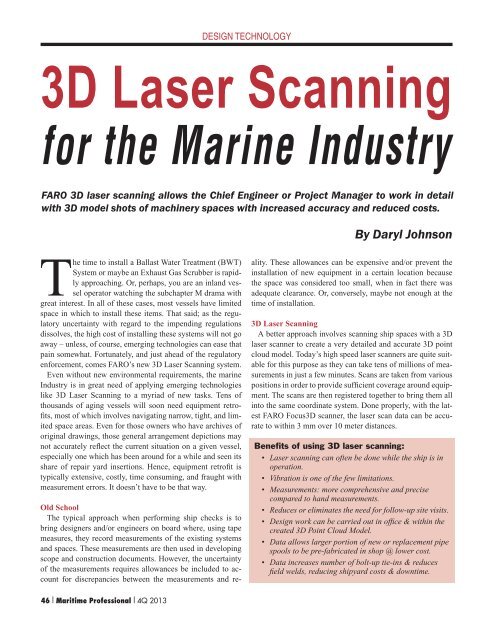1fjzeJ0
1fjzeJ0
1fjzeJ0
Create successful ePaper yourself
Turn your PDF publications into a flip-book with our unique Google optimized e-Paper software.
DESIGN TECHNOLOGY3D Laser Scanningfor the Marine IndustryFARO 3D laser scanning allows the Chief Engineer or Project Manager to work in detailwith 3D model shots of machinery spaces with increased accuracy and reduced costs.By Daryl JohnsonThe time to install a Ballast Water Treatment (BWT)System or maybe an Exhaust Gas Scrubber is rapidlyapproaching. Or, perhaps, you are an inland vesseloperator watching the subchapter M drama withgreat interest. In all of these cases, most vessels have limitedspace in which to install these items. That said; as the regulatoryuncertainty with regard to the impending regulationsdissolves, the high cost of installing these systems will not goaway – unless, of course, emerging technologies can ease thatpain somewhat. Fortunately, and just ahead of the regulatoryenforcement, comes FARO’s new 3D Laser Scanning system.Even without new environmental requirements, the marineIndustry is in great need of applying emerging technologieslike 3D Laser Scanning to a myriad of new tasks. Tens ofthousands of aging vessels will soon need equipment retrofits,most of which involves navigating narrow, tight, and limitedspace areas. Even for those owners who have archives oforiginal drawings, those general arrangement depictions maynot accurately reflect the current situation on a given vessel,especially one which has been around for a while and seen itsshare of repair yard insertions. Hence, equipment retrofit istypically extensive, costly, time consuming, and fraught withmeasurement errors. It doesn’t have to be that way.Old SchoolThe typical approach when performing ship checks is tobring designers and/or engineers on board where, using tapemeasures, they record measurements of the existing systemsand spaces. These measurements are then used in developingscope and construction documents. However, the uncertaintyof the measurements requires allowances be included to accountfor discrepancies between the measurements and reality.These allowances can be expensive and/or prevent theinstallation of new equipment in a certain location becausethe space was considered too small, when in fact there wasadequate clearance. Or, conversely, maybe not enough at thetime of installation.3D Laser ScanningA better approach involves scanning ship spaces with a 3Dlaser scanner to create a very detailed and accurate 3D pointcloud model. Today’s high speed laser scanners are quite suitablefor this purpose as they can take tens of millions of measurementsin just a few minutes. Scans are taken from variouspositions in order to provide sufficient coverage around equipment.The scans are then registered together to bring them allinto the same coordinate system. Done properly, with the latestFARO Focus3D scanner, the laser scan data can be accurateto within 3 mm over 10 meter distances.Benefits of using 3D laser scanning:• Laser scanning can often be done while the ship is inoperation.• Vibration is one of the few limitations.• Measurements: more comprehensive and precisecompared to hand measurements.• Reduces or eliminates the need for follow-up site visits.• Design work can be carried out in offi ce & within thecreated 3D Point Cloud Model.• Data allows larger portion of new or replacement pipespools to be pre-fabricated in shop @ lower cost.• Data increases number of bolt-up tie-ins & reducesfi eld welds, reducing shipyard costs & downtime.46 I Maritime Professional I 4Q 2013


